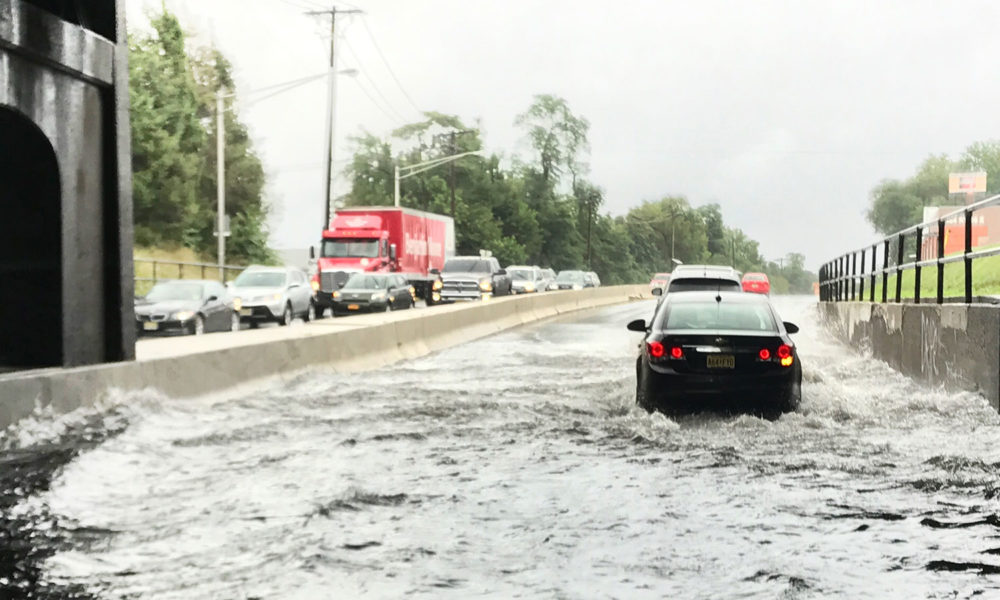Back in high school, my friends and I were struggling to come up with a name for our band, and somehow landed on New York Underwater. To us, this name had the right mix of refinement and rebelliousness to attract high-paying gigs like bar mitzvahs and corporate office parties. Undeniably though, at the front of our minds was the realities of Hurricane Sandy, which had then recently caused deadly flooding intensified by climate change.
Similar scenes from Hurricanes Elsa, Henri, and Ida over the past couple months bring back those memories and make clear just how devastating the climate crisis is and will continue to be without monumental action.
More than a third of New York’s global warming emissions, the same emissions that contribute to more destructive hurricanes, come from its transportation system. Whether it be the millions of gasoline-burning personal cars that serve 71% of New York households, or the more than 600,000 diesel-burning trucks that deliver the food and goods that keep the state running, or the jet fuel burned by transporting millions of passengers every year through the country’s busiest airport system, there are many opportunities to clean up transportation. The state needs to ramp up its efforts in transportation—it is outpacing all other sectors of the state economy for global warming emissions.
It’s time for the state of New York to shift into high gear on climate action, and one of the biggest steps to take is cleaning up its cars, trucks, and buses.
Bad for the climate, bad for the air
Tackling the global warming emissions from transportation not only helps address our longer term existential planetary crisis but makes sense in the near term when considering how burning fossil fuels pollutes the air we breathe and makes us sick. When fossil fuels and oxygen meet in a traditional combustion engine, water and global warming inducing carbon dioxide are emitted. Alongside this process, high heat also causes nitrogen in the air to oxidize into smog and soot-forming nitrogen oxides (NOx). Unavoidable, incomplete combustion releases smaller carbon particles with hundreds of other chemical elements such as fine particulate matter (PM2.5), much like a smoky campfire without enough air.
Breathing NOx itself can irritate our heart and lungs and worsen effects of asthma, especially in children and the elderly. NOx can then further react in the atmosphere to form additional PM2.5 and ground-level ozone (soot and smog). PM2.5 is responsible for 63 percent of environmentally caused deaths in the US, and has been linked to premature death, increased hospital admissions for heart and lung diseases, bronchitis, and worsening of asthma and chronic obstructive pulmonary disease (COPD).
While breathing dirty air affects everyone, the burdens are shared unequally. Black, Hispanic, and Asian New Yorkers are exposed to 28, 35, and 47 percent more particulate matter from on-road vehicles than the state average, respectively. This is concentrated in air pollution hot spots of Buffalo, Rochester, Syracuse, Albany, and New York City.

How will New York clean up transportation?
The fight for climate action in NY sped up in 2018 after Democrats won back the state legislature.
First, the Climate Leadership and Community Protection Act (CLCPA) was signed into law in July 2019 and set the stage with aggressive, legally binding targets for transitioning New York off fossil fuels. The legislation sets a target for 100% zero-emission electricity by 2040 and net-zero overall global warming emissions by 2050. That second goal cannot be reached without cleaning up transportation.
Second, because the CLCPA specifies that “disadvantaged communities shall receive no less than thirty-five percent of the overall benefits of spending” on clean energy investments, the legislature passed a separate environmental justice bill (a new Article 48 of the Environmental Conservation Law) that declared a right to environmental justice so the CLCPA could take effect.
Third, Governor Hochul signed legislation (A.4302/S.2758) this past summer setting goals for all new passenger cars and trucks sold in the state to be zero-emissions by 2035 and all new medium- and heavy-duty trucks and buses to be zero-emissions by 2045— the most that almost any state has committed to in cleaning up the transportation system.
With those goalposts in place, the next major push will be for adequate funding for the necessary investments. There are a few major funding conversations currently on the table including a global warming emission polluter fee, congestion pricing in New York City, taxing the state’s wealthiest individuals, and a bond voters will decide on next year.
What’s next for New York to tackle? Heavy-duty trucks.
With robust targets and hopes that the new governor will be a better partner on climate policy, the stage is set for climate policies that the state and the world desperately need. We must push harder and faster because the climate crisis is growing in intensity and scale with every day of inaction that goes by. For the state to get to net-zero emissions, we must also clean up the freight and shipping sector by pushing forward on electric heavy-duty trucks.
Though medium and heavy-duty trucks and buses make up only approximately 5 percent of the state’s 10.6 million registered vehicles, they contribute a disproportionate 52 percent of nitrogen oxide (NOx), 45 percent of fine particulate matter (PM2.5), and 24 percent of global warming emissions from all on-road vehicles. Given the long lifetimes and high usage of these vehicles, truck electrification is a technologically feasible way the state can realize substantial climate and health benefits.
UCS has been closely following the adoption of the Advanced Clean Truck rule in multiple states (e.g. New Jersey, Oregon), which is a first-of-its kind regulation that requires manufacturers to sell an increasing percentage of electric trucks per year. New York recently proposed its own rulemaking for this important program, which would result in $19.4 billion in net societal benefits by 2050. Substantial climate polices like the Advanced Clean Truck rule can help save our planet, allow us to breathe freely, and make economic sense through investing in our future.
What you can do
In this moment, Governor Hochul has a huge opportunity to lead the way in securing meaningful policies to drive down transportation pollution. The next few months will be crucial in getting some long-overdue, concrete policies on the books. You can make a difference, too, by contacting the administration and urging the Department of Environmental Conservation to adopt the Advanced Clean Truck rule as a first step. If New York adopts the rule by the end of the calendar year, the Empire State will be set up to participate in the program – ensuring cleaner air sooner for residents across the state. Everybody has the right to clean air, water, and a healthful environment.

